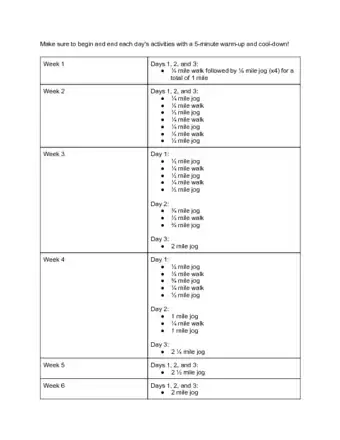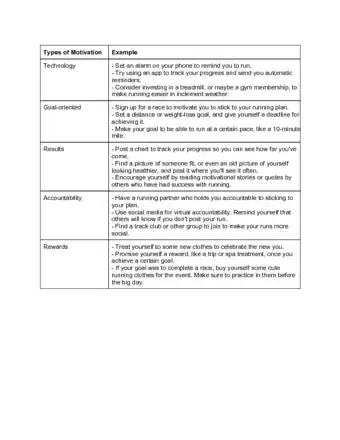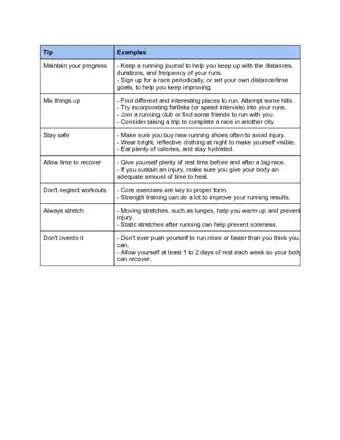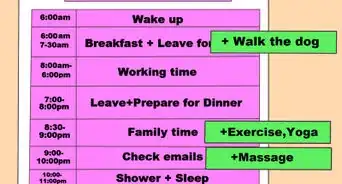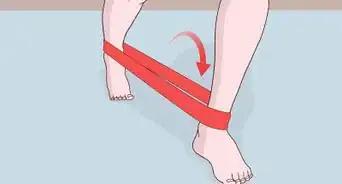This article was co-authored by Kai Ng. Kai Ng is a USATF and RRCA Certified Running Coach at Run Coach Kai. Kai has competed in over 55 races and over 15 marathons, and has trained with 16x USA and World record holder Patti Catalano Dillonso. He specializes in coaching runners of all levels and showing people that everyone can be a runner. Kai is committed to helping his clients reach their goals by showing them how to run with proper form and holding them accountable to train consistently.
There are 8 references cited in this article, which can be found at the bottom of the page.
wikiHow marks an article as reader-approved once it receives enough positive feedback. In this case, 100% of readers who voted found the article helpful, earning it our reader-approved status.
This article has been viewed 1,794,466 times.
Running has so many benefits: it relieves stress, strengthens your muscles, and makes your body lean. It's hard work at first, but after a few weeks your body finds its rhythm and you begin to crave the feeling of running free. You can start running right away and build up your endurance with a bit of persistence and hard work.
Steps
Running Help
Getting Out There
-
1Go outside and run. Now. The best way to start running is simply to put on a pair of running shoes and hit the pavement, dirt or grass. The motion of running will feel strange at first, as muscles that normally don't get much use spring into awkward action. This is normal. Run until your legs are burning and your chest is heaving; for true beginners, that usually occurs after about 5-10 minutes.
- When you're just starting out, you don't need fancy running shoes. An old pair of sneakers will do. Once you know you want to continue the sport, you can upgrade.
- Run in comfortable clothes. Put on gym shorts, a T-shirt, and a sports bra if necessary. Don't wear anything too constricting.[1]
- Run anywhere. Your neighborhood, in a park, up and down your driveway, on the local track at a school. One of the best things about running as a sport is that you can do it almost anywhere, and you're not chained to a gym.
EXPERT TIPTyler Courville is a brand ambassador for Salomon Running. He has run in 10 ultra and mountain races across the United States and Nepal, and won the 2018 Crystal Mountain Marathon.Professional Runner
 Tyler Courville
Tyler Courville
Professional RunnerAccording to Tyler Courville, ultra and mountain runner, “Really, the only item you need to go for a run is a good pair of running shoes, which is pretty great.”
-
2Use good form. Try to loosen your body and move forward in a way that feels natural. Pump your arms, take comfortable strides, stand upright with a slight forward lean, and pick your feet up high off the ground so you don't catch a toe in a crack in the sidewalk. Speaking of toes, it's best to run more on the toe or front of your foot, running on the heel will increase your chance of shin splints. Every runner has a slightly different gait, since everyone's body is different, so figure out what works for you.
- Avoid bouncing and try to land softly in order to reduce stress on your knees and other joints.[2]
- Find your stride. Recent evidence has come to light that your foot strike (toe, mid-foot, heel) is a natural occurrence that should not be altered. That being said, the faster you run the more forward on your foot your strike will be.
- Relax your upper body. Holding yourself stiff impairs mobility and makes you run slower. Keep your weight centered and your shoulders in a relaxed position, with your arms bent at 90 degrees.[3]
Advertisement -
3Breathe. Breathe naturally or focus on a breathing technique. Some argue that the best breathing technique is inhaling oxygen through the nose, fully expanding the lungs, and exhaling through a widely opened mouth. Your nose is a good filter for air, especially while running outdoors, which prevents you from accidentally swallowing bugs.[4] Exhaling through your mouth allows your body to get rid of more carbon dioxide and heat with less effort.
-
4Stretch when you get home. Although the benefits and/or drawbacks to stretching before a run are controversial, there is little argument about the benefits of stretching at the end of each workout. Stretch out each muscle group, holding each stretch for at least 15-20 seconds.[5]
- The most important muscles to stretch are your leg muscles. Stand a few feet from a wall and lean into the wall (moving one foot closer to the wall but leaving the other one a meter out) so that you feel your calf muscles being stretched. Do one side then the other.
- Bend your knee and lift your foot till your foot is back up near your butt. Hold that foot with your hand and bring it real close to your butt. You should feel a stretch along the front of your thigh. Swap sides. Alternatively, you can step forward and lunge into the front foot, keeping your knee behind your toe until you feel the stretch in your thigh. This will save your knees, instead of putting unnatural stress on the tendons and ligaments around your knee that could lead to future damage.[6]
- Standing near a table or a fence rail (at about hip height) try to put your foot up on the table or fence rail. Now try to straighten out your leg. You should feel a stretch along the back of your leg. Swap sides.
Starting a Routine
-
1Run at least three days a week. This is how you build endurance; running once a week won't cut it. Space out the days to allow for recovery time between sessions. Anything more goes beyond fitness and into running for other purposes, something you may find yourself doing if bitten by the running bug.
- Run rain or shine, in cold weather and hot. Just be sure to dress appropriately for the weather.
- Stay hydrated and eat light before running. Good rule of thumb is to eat 200-300 calories about 1.5 hours before the run.
- Try listening to music during your run. It won't work for everyone, but in some cases, it may help you maintain a steady pace. If you find that the tempo of the song disrupts your own natural tempo, however, quit listening.
-
2Add time and distance. As the weeks go on, push yourself to run further and for a longer period of time. If you ran 10 minutes at a time the first week, push yourself to do 15 the second week. Make it 20 the third week.[7] You'll soon find that you're able to go much longer before you feel like you have to stop. To build endurance, try these strategies:
- Don't worry about speed at first. In fact, you should really run more slowly than you think you should.[8] You're not running a race yet; you're increasing your fitness level. For now, focus on gradually decreasing the time or increasing the distance you run. The racing can come later, if you choose. Starting small is important to develop the habit of running.
- Alternate running and walking. Rather than stopping your exercise session when you feel like you have to stop, walk for a few minutes, then start running again.[9] Repeat over a period of 30 or 40 minutes. Next time you run, increasing the ratio of running to walking during the same 30 or 40 minute period. Eventually, get to the point where you're running the entire time.
- Do sprints. Running as fast as you can for a short period of time builds up your muscles and helps you gain endurance. Mix up your long running sessions with sprinting days. Use a stopwatch to time yourself. Start by sprinting as fast as you can for a quarter mile; do this 4-6 times. On your next sprinting day, try to beat your first time. Add more quarters as you gain endurance and strength.
-
3Map out some favorite routes. Running the same boring track day in and day out is going to make you feel burned out pretty soon. Treat yourself to a run in the woods, or in a neighborhood you've never explored before. Try to rotate your workout sessions between 2 or 3 different places to keep things interesting.
- Make it convenient. Find places to run near your home, work and/or school. Schedule workouts when you are least likely to be interrupted like early in the morning or on the way home from work.
- Be prepared for changes in plans by carrying some gear with you (in your car) when at work or school. That way if the traffic is terrible, you can go for a run until the traffic thins out.
-
4Don't give up too soon. After a few runs, you might be inclined to think you aren't cut out for running. You'll think to yourself, shouldn't this be more fun by now? Why does it hurt so much? Just keep going. Tell yourself you'll give it at least two weeks before throwing in the towel. After a few weeks of pushing yourself by following a running routine you will begin to feel lighter, faster, and you'll start having more fun. Eventually you'll realize you don't want to miss a run.
Advancing to Intermediate Level
-
1Obtain some good running shoes. If you're serious about this running thing, it's a good idea to have yourself fitted at a running store, as different shoes are designed for different types of feet.[10] The right shoe for one person is the wrong shoe for another and will cause injury. A good running store can test you to make sure you get the right shoe.[11] It is a good idea to bring along a used pair of shoes as the wear pattern can help determine the pronation of your feet. Identifying pronation will help you choose the right shoes to support your foot type.
- The person helping you can use an old pair of shoes to determine where you put the most pressure on your feet, and can help find the design that will most minimize injury.
- Your typical sporting goods store does not have the expertise to get you in the correct shoe.
-
2Train for a race.Competing in a race gives you a goal to work toward as you're learning to run. Once you've done one, you'll probably want to do more. To train for a 5K race, which is just over 3 miles (4.8 kilometers), follow a weekly schedule 3 days a week for a 2-month period:
- Week 1: Brisk five-minute warm-up walk. Then alternate 60 seconds of jogging and 90 seconds of walking for a total of 20 minutes.
- Week 2: Brisk five-minute warm-up walk. Then alternate 90 seconds of jogging and two minutes of walking for a total of 20 minutes.
-
Week 3: Brisk five-minute warm-up walk, then do two repetitions of the following:
- Jog 200 yards / 180 meters (or 90 seconds)
- Walk 200 yards / 180 meters (or 90 seconds)
- Jog 400 yards / 365 meters (or 3 minutes)
- Walk 400 yards / 365 meters (or 3 minutes)
-
Week 4: Brisk 5 minute warm-up walk, then:
- Jog 1/4 mile / 400 meters (or 3 minutes)
- Walk 1/8 mile / 200 meters (or 90 seconds)
- Jog 1/2 mile / 800 meters (or 5 minutes)
- Walk 1/4 mile / 400 meters (or 2-1/2 minutes)
- Jog 1/4 mile / 400 meters (or 3 minutes)
- Walk 1/8 mile / 200 meters (or 90 seconds)
- Jog 1/2 mile / 800 meters (or 5 minutes)
-
Week 5:
- Workout 1: Brisk 5 minute warm-up walk, then:
- Jog 1/2 mile (or 5 minutes)
- Walk 1/4 mile (or 3 minutes)
- Jog 1/2 mile (or 5 minutes)
- Walk 1/4 mile (or 3 minutes)
- Jog 1/2 mile (or 5 minutes)
- Workout 2: Brisk five-minute warm-up walk, then:
- Jog 3/4 mile / 1.2 kilometers (or 8 minutes)
- Walk 1/2 mile (or 5 minutes)
- Jog 3/4 mile (or 8 minutes)
- Workout 3: Brisk five-minute warm-up walk, then jog two miles / 3200 meters (or 20 minutes) with no walking.
- Workout 1: Brisk 5 minute warm-up walk, then:
-
Week 6:
- Workout 1: Brisk five-minute warm-up walk, then:
- Jog 1/2 mile (or 5 minutes)
- Walk 1/4 mile (or 3 minutes)
- Jog 3/4 mile (or 8 minutes)
- Walk 1/4 mile (or 3 minutes)
- Jog 1/2 mile (or 5 minutes)
- Workout 2: Brisk five-minute warm-up walk, then:
- Jog 1 mile /1.6 kilometers(or 10 minutes)
- Walk 1/4 mile (or 3 minutes)
- Jog 1 mile /1.6 kilometers(or 10 minutes)
- Workout 3: Brisk five-minute warm-up walk, then jog 2-1/4 miles / 3.6 kilometers (or 25 minutes) with no walking.
- Workout 1: Brisk five-minute warm-up walk, then:
- Week 7: Brisk five-minute warm-up walk, then jog 2.5 miles / 4 kilometers (or 25 minutes).
- Week 8: Brisk five-minute warm-up walk, then jog 2.75 miles / 4.4 kilometers (or 28 minutes).
- Week 9: Brisk five-minute warm-up walk, then jog 3 miles / 4.8 kilometers (or 30 minutes).
-
3Join a running group. Running with other seasoned runners will give you the opportunity to get feedback on your form, and provide motivation to stick with it. You can run races together or just run for recreational purposes. You'll find information about local running groups at running stores.
Expert Q&A
-
QuestionIs it possible to get ready for a 5k in a month if I just started exercising?
 Michele DolanMichele Dolan is a BCRPA certified Personal Trainer in British Columbia. She has been a personal trainer and fitness instructor since 2002.
Michele DolanMichele Dolan is a BCRPA certified Personal Trainer in British Columbia. She has been a personal trainer and fitness instructor since 2002.
Certified Fitness Trainer Being able to get ready for a 5k in one month completely depends on your fitness level and your expectations. See if you can cover a distance of 3.2k now. If you can, you will probably be able to work up to 5k in a month following the plan starting at week 5. If you are OK with a slower time or walking part of the 5k, then go for it!
Being able to get ready for a 5k in one month completely depends on your fitness level and your expectations. See if you can cover a distance of 3.2k now. If you can, you will probably be able to work up to 5k in a month following the plan starting at week 5. If you are OK with a slower time or walking part of the 5k, then go for it! -
QuestionWhat is a good distance to start running?
 Michele DolanMichele Dolan is a BCRPA certified Personal Trainer in British Columbia. She has been a personal trainer and fitness instructor since 2002.
Michele DolanMichele Dolan is a BCRPA certified Personal Trainer in British Columbia. She has been a personal trainer and fitness instructor since 2002.
Certified Fitness Trainer Assuming it's medically safe for you to start running, a great starting goal is one kilometer.
Assuming it's medically safe for you to start running, a great starting goal is one kilometer. -
QuestionHow do you condition yourself for running?
 Michele DolanMichele Dolan is a BCRPA certified Personal Trainer in British Columbia. She has been a personal trainer and fitness instructor since 2002.
Michele DolanMichele Dolan is a BCRPA certified Personal Trainer in British Columbia. She has been a personal trainer and fitness instructor since 2002.
Certified Fitness Trainer Gradually work up your length of time running. Once you have made it to 30 minutes 3 times a week, you can start to focus on other things like speed and distance.
Gradually work up your length of time running. Once you have made it to 30 minutes 3 times a week, you can start to focus on other things like speed and distance.
Running Tips and Tricks
Warnings
- If you are road running make sure you wear brightly colored clothes to help drivers of cars see you. It's is also not a good idea to wear headphones while road running.⧼thumbs_response⧽
- Consult a physician or other health-care professional before beginning any running program. This is most important if you are over 35, have bone or joint problems such as arthritis, or have risk factors for heart disease. Your body will thank you later for starting out at your healthiest.⧼thumbs_response⧽
- Always consume adequate amounts of fluids after, and during (if runs last more than 45 minutes or so) your runs, especially in the heat. If you feel at all thirsty, you are already dehydrated.⧼thumbs_response⧽
Things You'll Need
- Running shoes
- Suitable, comfortable running clothing
- A water bottle
References
- ↑ https://www.runnerschoice.net/blog/running-clothing
- ↑ https://www.nhs.uk/live-well/exercise/how-to-run-correctly/
- ↑ http://running.competitor.com/2013/06/training/the-five-most-common-running-form-mistakes_48731/5
- ↑ https://www.runtastic.com/blog/en/how-to-breathe-properly-while-running/
- ↑ https://www.nhs.uk/live-well/exercise/how-to-stretch-after-a-run/
- ↑ https://www.nhs.uk/live-well/exercise/how-to-stretch-after-a-run/
- ↑ Kai Ng. Certified Running Coach. Expert Interview. 12 February 2021.
- ↑ Kai Ng. Certified Running Coach. Expert Interview. 12 February 2021.
- ↑ https://www.active.com/running/articles/run-walk-run-to-faster-times-faster-recovery
- ↑ https://www.runtastic.com/blog/en/running-shoes/
- ↑ Kai Ng. Certified Running Coach. Expert Interview. 12 February 2021.
About This Article
To begin running, put on some comfortable clothes and running shoes or sneakers. Then, run slowly until your legs are burning and your chest is heaving, even if that only takes a few minutes. As you run, try to set the front of your foot down first to prevent injury. Set yourself a routine of running at least 3 days a week, and try to run 5 minutes longer every week. To keep yourself motivated, switch up your routes when you can, and try to keep them as convenient as possible. To hear more running tips from our reviewer, like how to breathe and when to stretch, read on!
